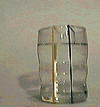A C T I V I T I E S

|
A C T I V I T I E S |
|
|
| Weather Way Down Under. |
| Fill a clear, shallow glass with warm water. You
should be able to touch the bottom of the glass
with a medicine dropper without getting your
fingers wet.
In a separate container mix 3/4 drops of red food coloring in about a 1/4 cup of cold water. If you wish, you can mix in a little pepper. Carefully use the medicine dropper to put a 4 inch layer of red water
at the bottom of the glass of plain water. (Don't try to squeeze out
all of the water from the dropper each time; this will stir up the
layers.) Rinse the dropper when you are finished. |




|
| In a separate container, mix 4-6 drops of blue
food coloring in about 4 tablespoons of
ice-cold water. Carefully support an ice cube
so it just touches the water. Try not to stir
up the water. (You may want to practice with
another cup first.)
Place one drop of cold, blue water on the edge of the ice cube every 5
seconds and observe what happens. How does the blue water affect the
red layer at the bottom of the glass? |




|
| You have created a simple model that shows how
cold, dense water sinks to the ocean floor off
the coast of Antarctica and pushes up sediments
containing rich nutrients left behind by
centuries of dying plants and animals. When
these nutrients rise to the level where
sunlight can penetrate the ocean water, the
nutrients are available to the microscopic
plants that form the base of food chains. This
eventually results in abundant numbers of fish,
seals, and whales on the top of the food chain. |
|
Click here to see a short (1205k) movie of the currents in action
(you'll need the Quicktime Plug-in or a video viewer configured on you computer) |
| |
activities
|
discussions
|
postcards
|
film
|
places
| |